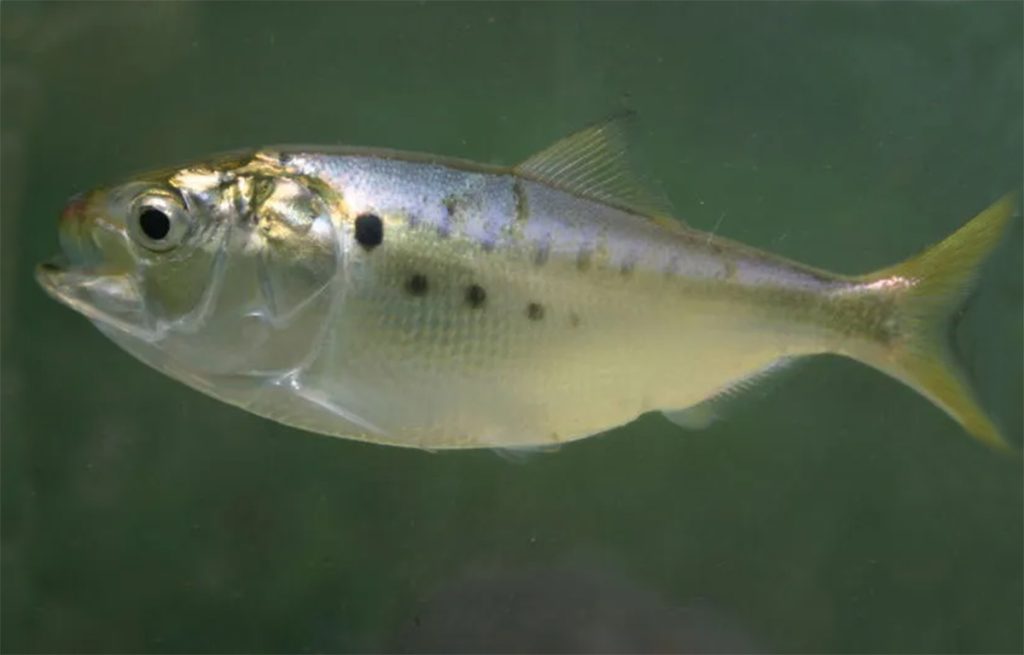
The surface waters along the shore seem to come to a low boil with a school of menhaden thrashing just below the surface. With a breeze blowing the right way, one might even detect their foul, oily odor. Mossbunker, bunker, porgy, bug-head, and fat-back as they are also called, probably never make it to the dinner table. As a meal, most people are likely to avoid the bony and smelly fish, but why are they such an important part of the coastal Atlantic and Gulf fisheries?
Early English settlers followed Native Americans’ suggestions of burying fish near freshly planted corn; decaying fish were a great fertilizer. Along with the occasional menhaden, many other species functioned as well. However, by 1820 a commercial fishery had developed for catching and processing menhaden into fertilizer. A few years later, oil was extracted from the fish for use in paints, tanning and dressing leather, and rope making. In addition, until petroleum came into wide use, its oil and that of whales were the main sources for illumination and lubrication. By 1870, 90 plants, from Maine to North Carolina were involved in processing the menhaden. In 2020, the majority of menhaden were taken by commercial fisheries; about 1% were landed by recreational fishermen. Omega Protein, located in Texas, processes the species into fishmeal and fish oil. The oil is ultimately used in producing fertilizer, cosmetics, feed for cattle, pigs, chickens, pet food and chumming bait. Omega 3 supplements that are said to help cut the risk of heart disease are also produced from their oil.

Atlantic menhaden range from Nova Scotia to north Florida. During the winter, females often spawn 20 to 30 miles offshore. Producing about 300,000 eggs per season, the buoyant eggs hatch in open water. Ocean currents carry the surviving larvae toward the sheltered coast. The developing juveniles then remain in estuaries until late fall when they migrate back offshore. Adults grow up to about 15 inches in length.
Menhaden gather among like-sized individuals, forming tightly packed, slow-moving schools that can, offshore, contain thousands of fish. They are filter-feeders, consuming microscopic-sized algae (phytoplankton) and very tiny crustaceans (zooplankton). Swimming with their mouths wide-open, they filter seawater through their gills at a rate of 4 to 7 gallons per minute!
The species is a sought-after prey for bluefish, stripers, mackerel, cod, bonito, swordfish, and tuna. They are also food for certain whales, dolphins, ospreys, eagles and other seabirds. Menhaden are known as keystone species; creatures that many other species in the ecosystem are dependent upon. In coastal estuaries, the menhaden’s filter-feeding may also contribute to the environment by ingesting harmful algal blooms.
Depending on the water temperature, wintering menhaden begin returning to Long Island Sound sometime in April. This can occur a little later, farther north and sooner, to the south. Their arrival, which is announced by churning waters, can be spotted from a boat or a dock that extends out into deeper water.
Snagging menhaden for bait can be accomplished using a casting rod armed with a weighted treble hook. When using such a rig, be sure to sharpen the hooks using a fishing hook sharpener. If the fish are surfacing, retrieve the treble hook close to the surface, jerking the line frequently. Even when attempting to snag deeper running fish, jerking the line is important.
Snagged fish generally die fairly soon, even when put in a livewell or a large pail with an aerator. When using a pail, change the water often. When not badly wounded, the fish may be used as live bait. But if dead, they can be used as chum or bait. When using them as bait, cut the fish into approximately two-inch pieces and attach them to a single curved hook with a wire leader. Previously frozen menhaden don’t hold up well as bait; they are generally too soft.
Menhaden oil (Menhaden milk) can also work as a fish attractant. The product is available in bottles and a drip dispensing system with a long tube. Hung off the side of a boat, the tube releases the oil into the water. It is also recommended that bait, chum, and lures are soaked with their oil.
Netting menhaden is the best way to save them as live bait. A 4 to 5-foot radius cast-net with 1-inch mesh or a 5/8-inch mesh with 1.5-pound lead per radius foot, are often suggested. Other recreational fishermen use gillnets with nearly invisible mesh. However, some states regulate recreational menhaden gillnetting. Check with your own state for such regulations.
The advantage of netting is of course that live fish are retrieved. However, they require a round-cornered livewell rather than one that is square. Menhaden swim nonstop. In a square tank, they tend to strike corners, injure themselves and eventually stop swimming. If kept overnight in a bucket with a good aerator, place it in a cooler and surround it with ice. With a maximum of three or four fish in the pail, they are then more likely to survive.
When fishing with live bait, insert a large circle hook just in front of the menhaden’s eyes. That allows the baitfish to swim with less restriction.
Menhaden (bunker) have proven to be one of the best baits for a long list of predatory fish found along the Atlantic coast. Be sure to try them.
